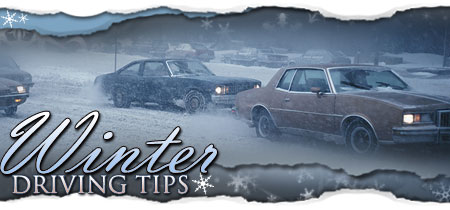| 
Safe Winter Driving Tips from Bridgestone Tires
Bridgestone
worked with IMSA and SCCA championship race car driver Peter Cunningham
(also a three-time national ice driving champion), in developing these safe
winter driving tips.
During
winter months, keep abreast of weather reports in your area. If snow or ice is
predicted, make plans to leave early or arrive later. An alarm clock set to an
earlier time can be a good friend in helping you avoid difficulties.
If
you can move a night trip to daylight hours, do so. Not only is visibility better,
but if your vehicle is stalled, you are more likely to receive prompt assistance
during the daytime.
Prepare
your vehicle for winter driving; use this checklist:
1. Check windshield wiper blades to make sure
they work properly. In some areas, snow blades are an effective alternative to
conventional wiper blades.
2. Have
your mechanic test the anti-freeze/coolant to provide the correct level of protection
required in your driving area.
3.
Make sure your tires are properly inflated. Underinflation can reduce the gripping
action of tires because the tread will not meet the road surface as it was designed
to do. Overinflation has the same effect.
4.
If you live in areas where snow and ice are certainties of winter, don't
depend on all-season tires. Instead, install snow tires. Snow tires are made of
softer components and have a unique tread design that provide better traction
and road-gripping abilities.
5.
Keep your gas tank at least half-full. The extra volume can help reduce moisture
problems within your fuel system. It also adds helpful weight to your vehicle.
6.
In rear-wheel drive vehicles, extra weight in the trunk may be helpful.
Use care-- unsecured weight can shift while you are moving or if you have to stop
suddenly. Bags of sand can provide weight and, if sprinkled on the ice, sand helps
provide traction.
-
Before
you leave your driveway, scrape the ice and snow from every window and the exterior
rear view mirrors, not just a small patch on the windshield. Don't forget to remove
snow from headlights and brake lights.
-
Try to remove ice and snow from your shoes before getting in your vehicle. As they melt, they create moisture build-up, causing windows to fog on the inside. You can reduce this fogging by turning the air recirculation switch to the OFF position. This brings in drier, fresh air. Also, run your air conditioner which becomes a dehumidifier for a few minutes.
-
You and your passengers should all use safety belts, both lap and shoulder straps.
-
Adjust head rests. Rear-end collisions are common in winter driving and a properly-adjusted head rest can prevent or reduce neck injuries.
-
Before you shift into gear, plan the best route to your destination. Try to Avoid hills, congestion areas and bridges.
-
Although your radio can provide helpful traffic information, it can also be a distraction for some drivers. Since driving is more a mental skill than a physical skill, you may want to keep it turned off.
-
Don't use a cellular phone when driving on ice or snow. Even if you have a hands-free model, you need to concentrate on driving, not on a telephone conversation.
-
Drive slowly and remember posted speed limits identify the maximum speed allowed in ideal weather conditions. Law enforcement agencies can write citations to motorists driving the posted speed limit if weather conditions warrant a slower speed. Be alert to the actions of other drivers.
-
Anticipate cars coming from side streets and put extra distance between your vehicle and the one in front of you. If someone is too close behind you, don't speed up; slow down or let them go around you.
-
To make sure other drivers see you, always drive with your lights on. At night, in fog and heavy snow conditions, low beams may be more effective than high beams.
-
Keep a light touch on the brakes. Even with anti-lock braking systems (sometimes called ABS), apply light pressure to avoid locking the brakes and causing a skid. Pumping the brake pedal should be smooth action, going from light to firm. Tip toe to slow is a good motto for winter drivers.
-
Keep both hands on the wheel and keep the wheel pointed where you want your car to go. While it may sound overly simple, it could help you in a skid. While manual transmissions may provide greater control to assist with braking, be careful when using downshifting as a way to slow the vehicle. Gear changes, particularly abrupt ones, can upset a vehicle's balance and cause a skid to occur, especially in turns.
-
Keep your vehicle stocked with simple emergency equipment in case you do get stalled or have an accident. Consider keeping these items in your vehicle:
- blanket or extra clothes
- candle with matches
- snacks
- beverages (never alcohol)
- flares
- C. B. radio, cellular phone or ham radio
- a small shovel
- flashlight
- windshield scraping device
- tow rope
- bag of sand or cat litter for traction
- long jumper cables
(for more on building a winter emergency kit, click here.)
If you do have trouble, run the engine only briefly to run the heater, not continuously. Carbon monoxide can accumulate more easily in a non-moving vehicle.
Severe engine damage may occur if the motor runs for long periods when the vehicle is not in motion. Warming up a car prior to travel is a common practice, but most engines don't need more than a minute at most to circulate oil to all internal parts. Check your vehicle's owner's manual for information about your engine.
(source: tiresafety.com)
|